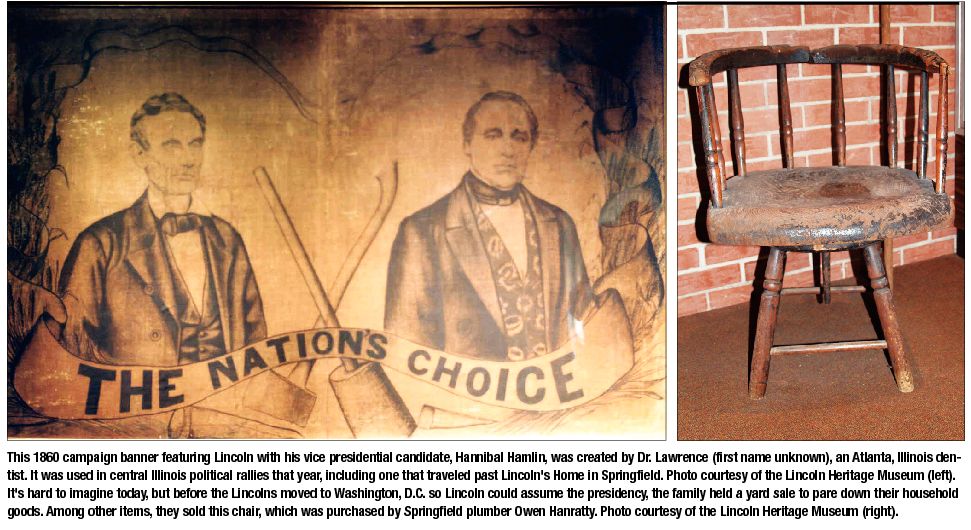
The Lincoln Museum at Lincoln
A small, no-frills place to see quality artifacts up close
HISTORY | Tara McAndrew
Not all Lincoln museums are alike. Compare, for example, the Abraham Lincoln Presidential Library and Museum (ALPLM) in Springfield and the Lincoln Heritage Museum in Lincoln. While the ALPLM uses state-of-the-art technology and recreated, life-size scenes from Lincoln’s life to tell his story, the much smaller Lincoln Heritage Museum at Lincoln College relies on artifacts to bring him to life. There’s a special thrill in being only inches and a glass pane away from Lincoln’s handwritten political notebook, Mary’s mourning veil, locks of their hair and other personal items.
Walking into the 1,000-square-foot Heritage Museum is a bit like walking into the well-kept attic of a Lincoln and Civil War buff, who explains the history of items tucked into its nooks and crannies.
“We’re small, so we can give a personal touch when people come in,” says museum curator Ron J. Keller. “We don’t have one particular artifact (that’s our claim to fame), but I think we have many unique things, things you just don’t see in a lot of museums.”
The museum and college are proud of their Lincoln connections. The town was named after and christened by Lincoln, and the college, also named for him, was founded on Feb. 12, 1865 — the last birthday Lincoln lived to see.
The museum was created when Lawrence Stringer, a Lincoln College graduate, lawyer, and Lincoln buff, donated his Lincolniana collection to the college upon his death in 1942.
That collection grew in the 1970s and 1980s, according to Keller, when Lincoln historians Ralph Newman and James Hickey urged Lincoln collectors to donate their items to the museum. Now its artifacts number around 20,000 and reflect the Civil War, Logan County history, the terrorist attacks on 9/11 and, of course, the Lincolns.
“The last direct descendant of Lincoln, Robert Todd Lincoln Beckwith, who died in 1985, was a benefactor of the college and he donated quite a few things,” says Melissa Weissert, the museum’s assistant director. These include Mary Lincoln’s personalized handkerchief and monogrammed towels, which lay next to her delicate black mourning veil, petite arm-length gloves, laced undershirt, and jewelry.
Plates and the dinner bell from the Lincolns’ home are displayed as well. “There are stories that Mary would have dinner ready and Lincoln would still be at the law office and she would send one of the boys to get him, so who knows if the bell was used much,” says Weissert.
That may not have been the case for a wellworn wooden chair on exhibit. Before the Lincolns left Springfield for Washington, D.C., they held a yard sale. Springfield plumber Owen Hanratty (a foreman at the Baggott Plumbing Company) bought this little chair there and kept it in his office, where “people would come and ask to sit in it,” Weissert says.
Four books Lincoln owned, including a volume of Shakespeare, reflect the intellectual Lincoln we all know, but sitting beside them are several tools, which show the less well known man — Lincoln as husband and homeowner.
Other artifacts provide a glimpse of a country mourning Lincoln the President. There is a decorative panel from the interior of his funeral train, ribbons and pins worn by mourners, and two silvery tassels that adorned the platform upon which his coffin rested when his body laid in state at the Statehouse (now the Old State Capitol) in Springfield.
“I visited (the museum) a while back and was impressed with the quality of their holdings and the way in which they were presented,” says Dr. Michael Burlingame, a Lincoln historian and Lincoln Studies Chair at University of Illinois Springfield.
The way they’re presented is going to change. By the summer of 2012 Keller hopes to open a new space for the museum in the College’s Lincoln Center, which will quadruple its exhibit area. Planners are meeting with designers to update exhibits, too.
“Our museum is very old-fashioned. I choose to say we have a classical approach,” Keller says, smiling. “Technology is not incorporated in our exhibits. Storytelling is a needed component in any history museum, so we want to do more visual interpretation with items we have, have some more technology and get more into the 21 st century.”
Keller says he’s talked to BRC, the company that helped design the ALPLM, but “we want to be different and put our own stamp on it. We don’t want to do anything that would replicate what (the ALPLM) has done.
“Our theme will concentrate on the Illinois Lincoln… I don’t think the ALPLM concentrates a great deal on Lincoln’s law career” and how it affected Illinois and Lincoln. “We have some great stories to tell,” he says.
Contact Tara McClellan McAndrew at [email protected].